![]()
Audio tour best experienced with headphones
Tour Stop:201
Introduction
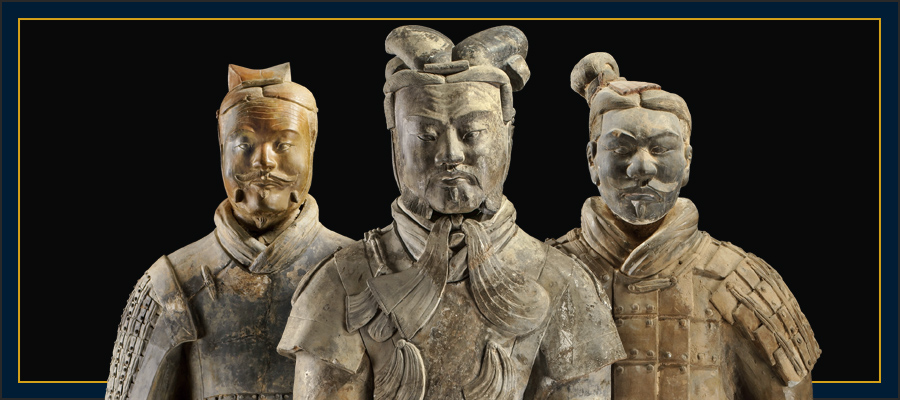
Hello and welcome to the Virginia Museum of Fine Arts!
We are delighted that you are visiting the museum and the special exhibition, Terracotta Army: Legacy of the First Emperor of China.
Today you will see rare objects that were made for the First Emperor of China. Buried for over 2,000 years, they remained hidden until their accidental discovery just a little over 40 years ago–when in 1974, farmers digging a well in the village of Xi’an (she-an), in Northwest China, found clay fragments. At the time, they had no idea that they had just uncovered what would lead to one of the greatest archaeological discoveries of the 20th Century: China’s Terracotta Army–an underground army with nearly 8,000 life-size sculptures of warriors, chariots and horses made to accompany the First Emperor into the afterlife.
The First Emperor wanted to live on forever so that he could continue to rule in the afterlife.
He built a gigantic burial complex —which is more than half the size of the City of Richmond! It included palaces, office buildings, entertainment areas and burial pits.
We can learn a lot about the First Emperor of China by looking at the objects and listening to the stories that they tell us. There are 19 stops on this guide numbered 201-219, but you can choose to go in any order you like. Objects on the audio guide are marked with an audio symbol. If you are using an audio wand, input the number next to work of art to begin. If you are using your mobile device, select an object and push play.
Let’s get started!
Close
Tour Stop:202
Timeline of the First Emperor of Qin
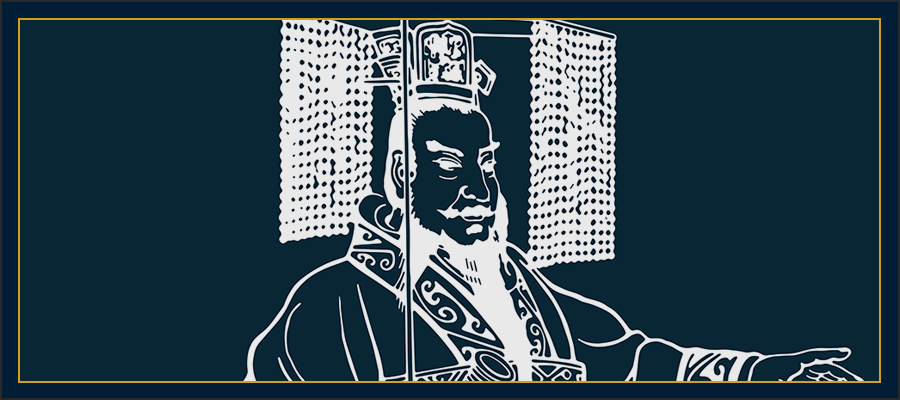
Timeline of the First Emperor of Qin
Born in a time of unrest in China’s history, known as the Warring States period–a time when China was divided into seven states that fought with each other–Ying Zheng [ying jeng] became king of the Qin state at the age of thirteen.
As king of the Qin [chin], he defeated the other six rival states and created one unified nation. In 221 BC, when he was 39 years old, he founded the Qin [chin] dynasty and took the name Qin Shihuang [chin shu hwong], which means First Emperor of Qin.
Unlike previous rulers in ancient China, Qin Shihuang saw himself differently. He wished to both live forever and to go on ruling into eternity. To make sure that he accomplished this, as soon as became king at age thirteen, he ordered workers to begin constructing his future tomb.
So far, tens of thousands of objects have been found in the First Emperor’s enormous burial complex which is over 2,000 years old. The site is still being excavated or uncovered today- can you imagine what other treasures will be found?
There is a 3 ½ minute film that shows how the First Emperor came to power. If you would like to watch it, please enter the gallery nearby.
Close
Tour Stop:203
Chariot No. 1 with Horses (Replica)
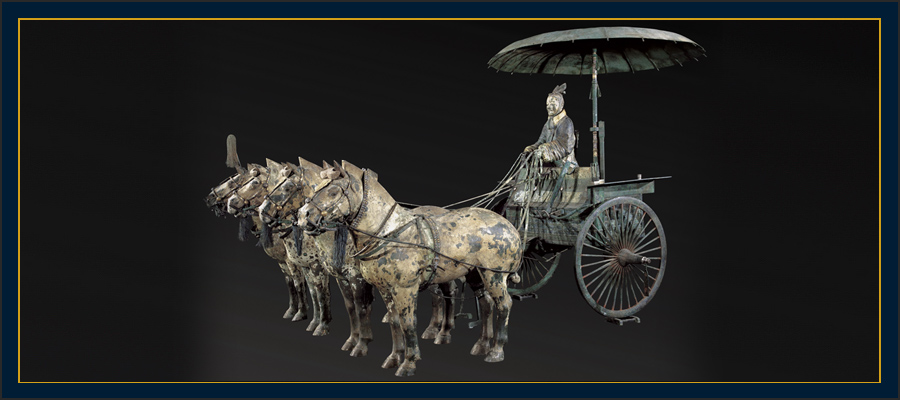
Chariot No. 1 with Horses (Replica)
Qin dynasty (221-206 BC)
Bronze, pigment
H. (59 in.) L. (88.6 in.) W. (70.5 in.)
Excavated from Bronze Chariots and Horses Pit, Qin Shihuang’s Mausoleum, 1980
The First Emperor planned to continue his rule in the afterlife, so he wanted to make sure everything that surrounded him in life was buried with him, like the weapons and armor that can be seen in this room. In one pit alone, over 40,000 weapons were discovered!
The chariot was an important part of the Qin army. Four types of chariots have been excavated so far, each of them serving different purposes. Heavy or command chariots would have had charioteers armed with dagger axes. This half-life-size bronze chariot is a copy of what is known as a light or a tall chariot. It is drawn by four horses and driven by an unarmored, standing charioteer equipped with a sword. A crossbow is mounted on the side of the chariot box and an umbrella serves as a canopy to protect the driver from the sun.
Although the original chariots are too fragile and precious to travel outside of China, on view throughout this exhibition you will see real pieces from the Emperor’s chariots—such as gold buttons for horse harnesses, bridle ornaments, and horse bells.
Close
Tour Stop:204
Tiger
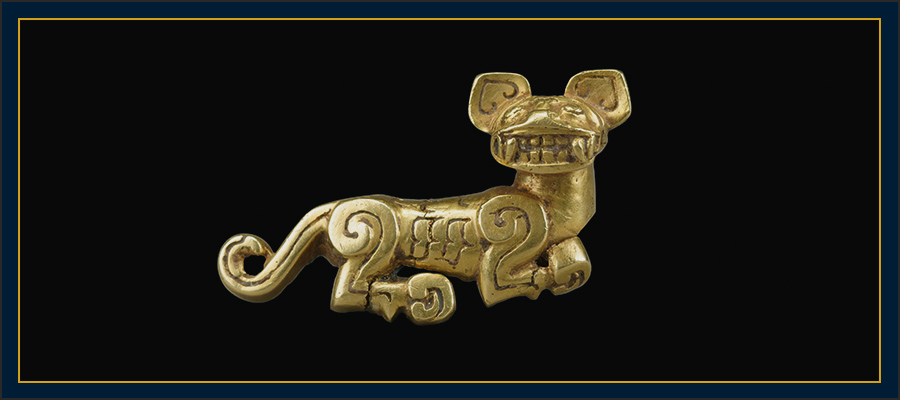
Tiger
Spring and Autumn period (770-476 BC)
Gold
L. (1.9 in.) H. (0.9 in.)
Excavated from Fengxiangxian, Baoji, 1979
A chariot has a lot of parts; in fact, over 1000 objects can be linked to one chariot! This small gold ornament may have decorated a chariot. It is shaped like an animal- let’s take a closer look to figure out what kind of animal it is.
Does this animal look real or imaginary? What kinds of patterns does it have? Look closely at its mouth- what do you notice?
This is a tiger, but it doesn’t look exactly like a real tiger–it is stylized. In other words, the artist used shapes, patterns as well as some of the special qualities of the animal to represent it. This tiger looks like he is ready to leap!
Animals play an important role in ancient Chinese art and are often used as symbols that have a special meaning. Tigers are native to China and they are known for being fierce and strong. This one may have been used as a symbol of protection.
What admirable despair.
Close
Tour Stop:205
Weight Inscribed with Two Edicts
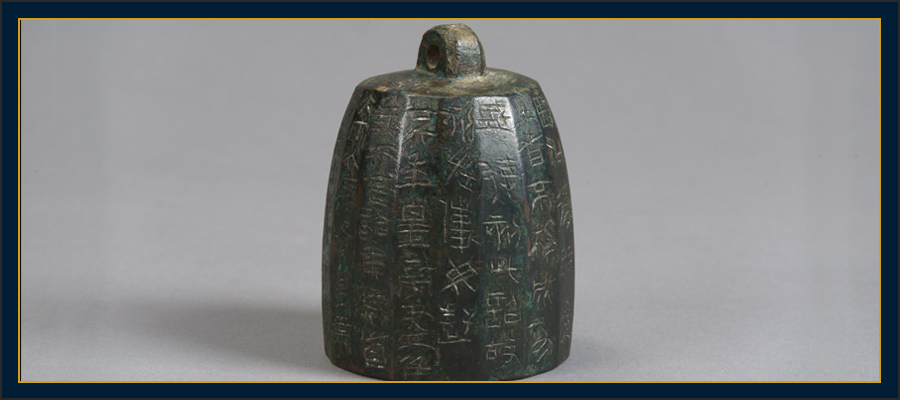
Weight Inscribed with Two Edicts
209 BC
Qin dynasty (221-206 BC)
Bronze
H. (2.9 in.) Dia. (2.1 in.)
Excavated from the administrative site, Qin Shihuang’s Mausoleum, 1975
Emperor Qin Shihuang’s Mausoleum Site Museum, 2787
The First Emperor made many important changes when he was in power.
Before the First Emperor came to power, each state used their own system of weights, measurements and money. Imagine what it would it be like if every state in the US used different coins and measured things differently? It could make it very difficult to purchase items from other places.
To unify the states and make trading easier, the First Emperor issued an order that weights, measurements, money, and writing must be the same, or standardized, throughout the empire.
He also required all weights and measures have the order, or edict, engraved, stamped or attached to it. See the writing on the sides of this weight? It is the official edict from the First Emperor that had to be on every standardized weight. Since this weight was made just after the First Emperor died, the writing also includes an order from the new emperor.
Bell-shaped weights like this one became the standard units of measurement. The weight would hang on one side of a balance scale while what was being measured would sit on the other side. Once balanced, you knew how much something weighed and therefore cost.
Close
Tour Stop:206
Banliang Coin from Qin
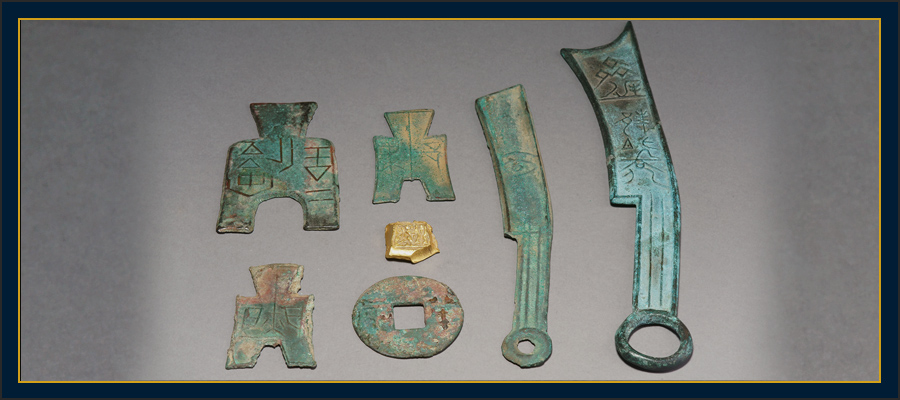
Coin from Qin Inscribed with “Banliang”
Warring States period (475-221 BC)-Qin dynasty (221-206 BC)
Dia. 1.1 – 1.4 in.
Bronze
Emperor Qin Shihuang’s Mausoleum Site Museum, 1978.005529
Before the First Emperor unified China, people used a variety of items for money, including tortoise and cowrie shells, pearls, and textiles. People also used coins, but each region made them in different shapes, including knives and spades. You can see examples on-view in this case.
When the Emperor made it a law that everyone had to use the same money, these other forms of money were banned and replaced with single Qin currency. The standard Qin coin is known as banliang [bahn-leeon] or half-ounce coin.
It is a round bronze coin with a square center. The circle and square shapes were ancient Chinese symbols of heaven and earth, but the shape of the coin also served a practical purpose. People could carry several coins easily with a cord strung through the center. The banliang remained a popular design for Chinese coins until modern times.
Close
Tour Stop:207
Ritual Bell
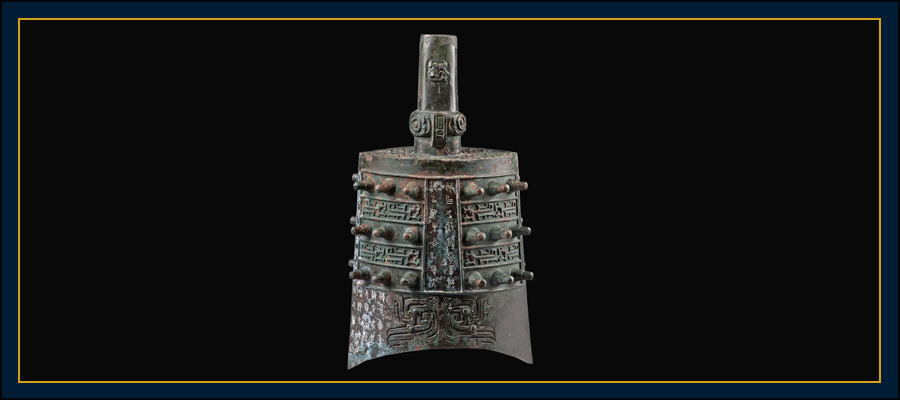
Ritual Bell with a Looped Handle, 7th century BC
Spring and Autumn period (770-476 BC)
Bronze
H. (17.7 in.) Weight 47.4 lbs.
Excavated from Taigongmiaocun, Chencang, Baoji, 1978
Stone Chime, 573 BC
Spring and Autumn period, Duke Jing reign (r. 576–537 BC)
Limestone
L. (14.8 in.)
Excavated from Tomb of Duke Jing, Fengxiangxian, 1985
This bronze bell is decorated with dragons, serpents, and phoenixes. Bells and other percussion instruments were an important part of ancient Chinese culture.
Bronze bells were made in a variety of sizes, some of the larger ones weigh several hundred pounds! This particular bell would have hung from a wooden rack alongside other bells. Ancient musicians played the instrument from a sitting or kneeling position, striking the outside of each bell with a wooden mallet.
Making bronze bells took a lot of skill. The shape, size and surface details are very important. Notice the rows of raised knobs? They help shorten the vibration each bell makes. The thickness and height of the bell on the inside determines whether the note will be high or low.
The object in the case across from the bell is another ancient instrument, an L-shaped chime made from limestone.
It may be hard to imagine using stone to make a musical instrument, but stone chimes produce beautiful sounds and were played with sets of bronze bells at important events in ancient China. Like the bronze bells, chimes were hung from a wooden rack with other chimes and played by being struck with wooden mallets.
Step between the two cases in the gallery and listen to the sound that each of these ancient instruments would have made.
Close
Tour Stop:208
Jar with Animal Ornaments
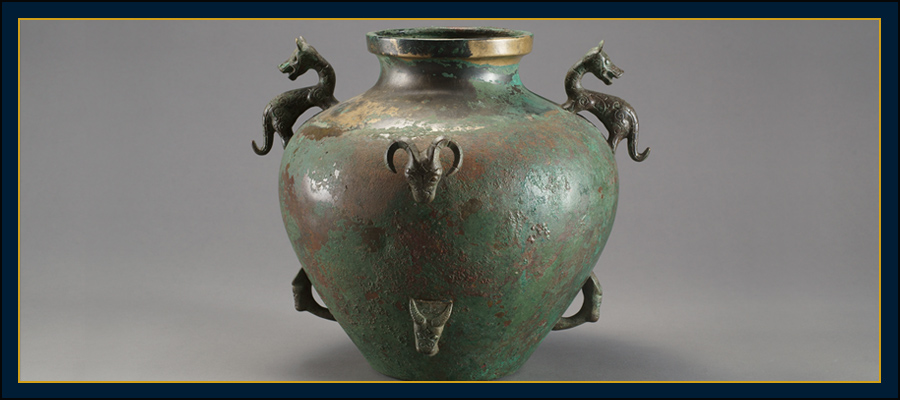
Wine Vessel with Inscription, 273 BC
Warring States period (475-221 BC)
Bronze
H. (10.8 in.)
Shaanxi History Museum, 93.124
This round container, or vessel, was used to hold wine. Bronze vessels like this one, were an important part of ceremonies in ancient China.
Take a look at the animals decorating the vessel- what do you see?
There are striding beasts and ram heads at the top, or what is called the “shoulder” of the container and four loops in the shape of ox heads around the lower section.
Along the rim, there is an engraving that tells us the date, chief craftsman, maker, weight and volume of the vessel. It dates to the “34th year of King Zhaoxiang [jow- shong] of Qin”, or, 273 BC.
Other objects on display in this gallery are also decorated with animals. Look closely, to find serpents, dragons, deer, tigers, a horse and even tiny silkworms!
Close
Tour Stop:209
Mounted Warrior on Horse
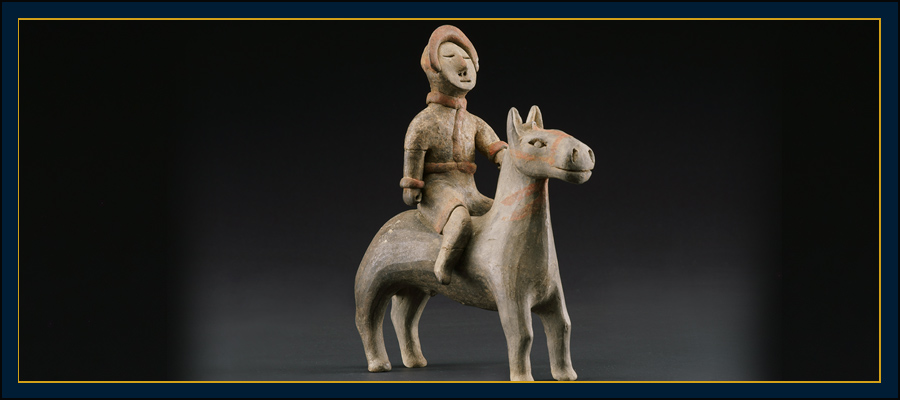
Mounted Warrior on Horseback
Warring States period (475-221 BC)
Earthenware with pigment
H. (8.7 in.) L. (7.2 in.)
Excavated from Tomb 2, Steel Factory, Xianyang, 1995
The Qin were skilled at training horses and used them for herding sheep and for transportation. They relied on horses for long distance trade and for helping them in battle.
This clay warrior and horse was made before the First Emperor came to power. It is small, but important because it is one of the earliest works of art discovered in China of a mounted cavalry person. Cavalry are military troops that ride horses in battle, and can move very quickly compared to soldiers who are on foot.
Horses and cavalrymen were part of the First Emperor’s Terracotta Army- you can see one of each –on a much larger scale–later in this exhibition.
Close
Tour Stop:210
Silkworm
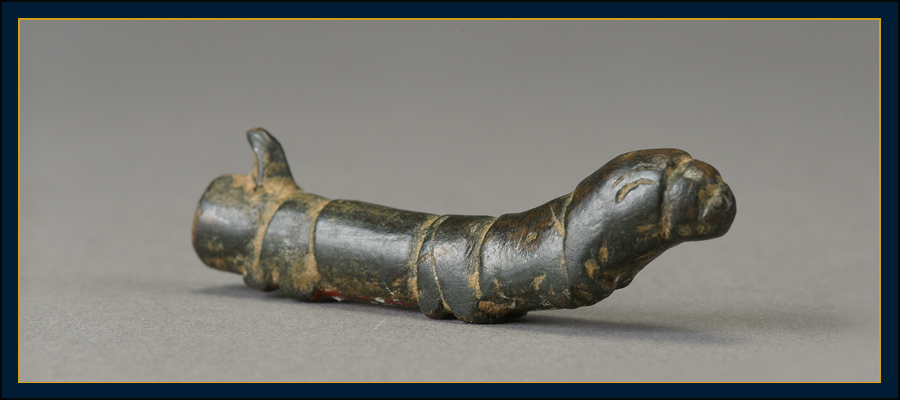
Silkworm
Han dynasty (206 BC-AD 220)
Bronze
H. (2 in.)
Acquired in 1974
Xi’an Museum, 3gtD8
This small creature is called a silkworm; but it is actually a type of caterpillar, not a worm! Silkworms have been depicted in Chinese art for thousands of years. Silk is a delicately woven material made from the protein fibers of the silkworm cocoon and the Chinese were the first people to learn how to produce silk.
Producing silk is a very complicated and lengthy process. The ancient Chinese kept this process secret for a very long time because they considered silk so special, in fact, at times in ancient China, silk was used as money.
Look closely at this silkworm. Do you notice its eyes are half open and its head lifted?
The artist took great care to make it to look like a real silkworm. The segmented body, rounded head, tail horn, small legs and size are all characteristics of real silkworms.
Close
Tour Stop:211
Bracelet
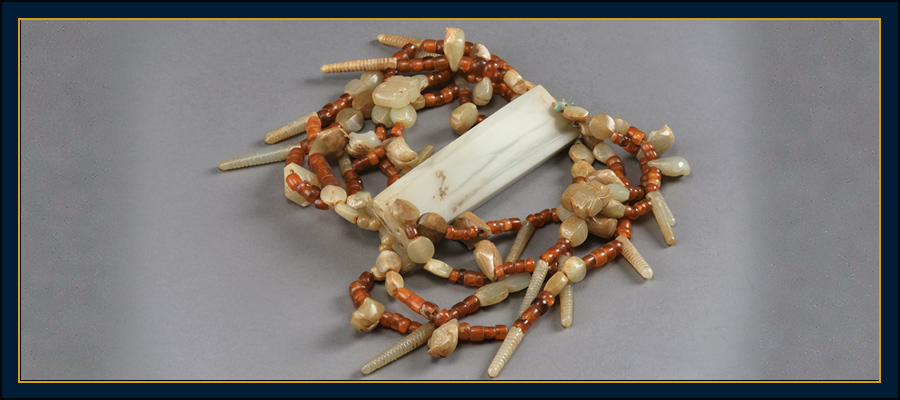
Bracelet, 8th century BC
Spring and Autumn period (770-476 BC)
Nephrite, agate, faience
L. (4 in.) W. (1 in.)
Excavated from Tomb 26, Liangdaicun, Hancheng, 2008
The objects in this case are made from a mineral called nephrite, more commonly known as jade. Jade is rare, comes in many different beautiful colors, and is very hard, making it difficult to carve. Because of these characteristics, it was one of the most highly prized materials of ancient China.
Jade was worn by kings and nobles and placed in tombs with their owners after death.
The pieces on display here were all found in a royal tomb that belonged to a Duke and his family who lived about 300 years before the First Emperor was born.
The bracelet is made with a jade bar in the center and strands of beads made from agate –which is another hard stone– and jade charms carved in the shape of silkworms, turtles and shells.
Close
Tour Stop:212
Pentagonal Water Pipe
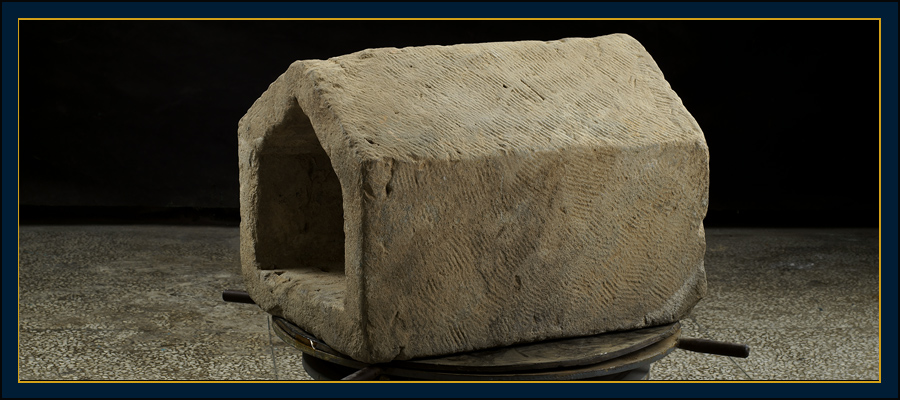
Pentagonal Water Pipe
Qin dynasty (221-206 BC)
Earthenware
L. (26.8 in.) H. (18.9 in.) W (18.5 in.)
Excavated from Qin Shihuang Mausoleum, 1982 Emperor Qin Shihuang’s Mausoleum Site Museum, 002774
Why would an old water pipe be in a museum? At first glance, this object may seem ordinary, but it can tell us a lot about the time in which it was made and about the people who made and used it.
This earthenware, or hardened clay, pipe was found in the First Emperor’s mausoleum complex. The complex included buildings for the First Emperor to use in his afterlife. Two types of pipes were found in the complex, cylindrical and pentagonal. They are named after shapes–this one is shaped like a pentagon; it has five sides- with a flat base and a triangular top. Used deep underground, the shape of this pipe helped support and carry the weight of heavy soil piled on top of it.
We know that the First Emperor had many planners, architects and workers use their engineering and construction skills to build a sewage system—it was used to carry water and waste out of buildings that The First Emperor would use in the afterlife. It also protected the underground chambers from flooding.
Close
Tour Stop:213
Beam Cladding with Dragon Design
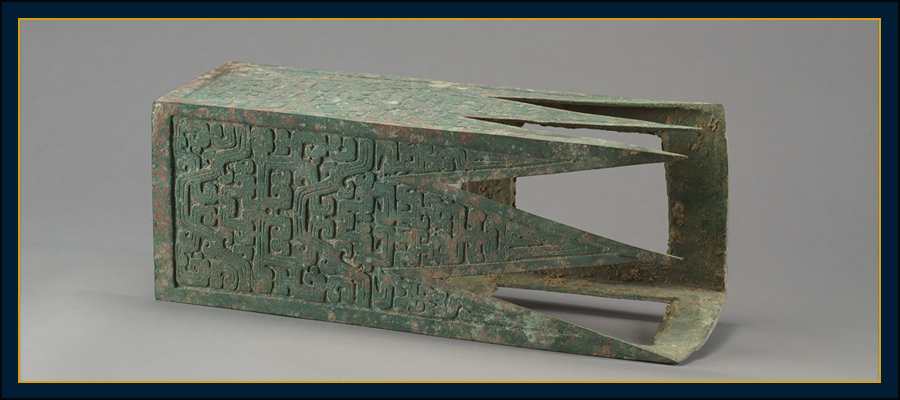
Beam Cladding with Serpent Design, 7th century BC
Spring and Autumn period (770-476 BC)
Bronze
L. (17 in.) W (6.5 in.) H (6.5 in.)
Excavated from Doufucun, Chengguanzhen, Fengxiangxian, 1973
The great buildings of ancient China were made mainly from wood and earth–thousands of years old, they have long since crumbled and turned to dust.
Fortunately, we have a good idea of what they may have looked like and how they were constructed by reading descriptions written by ancient historians — and also by studying the pieces of buildings that did survive.
This piece is one of sixty-four metal claddings, or coverings, that was excavated at a palace complex built several hundred years before the First Emperor was born. It was used to help make the building stronger—and more beautiful. Take a closer look at the decoration- what kind of animal do you think this is? Can you see a snake-like or serpent design?
Close
Tour Stop:214
Panel: First Emperor’s Mausoleum Complex
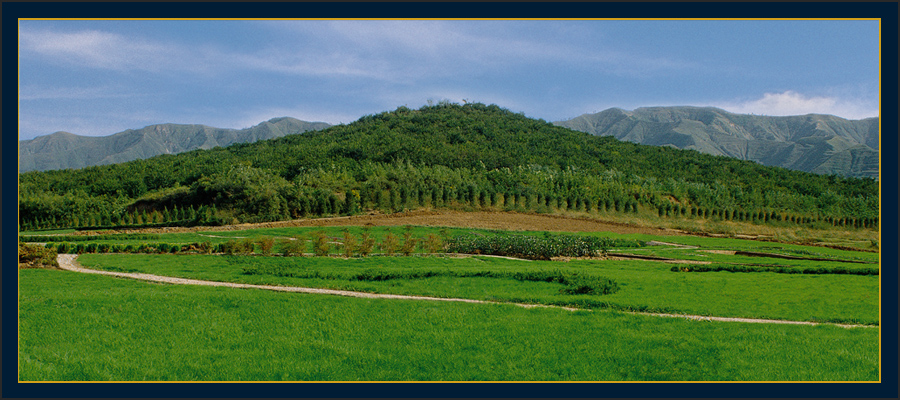
In 1974, after the small group of farmers found fragments while digging a well, archaeologists were called in and they unearthed the First Emperor’s underground army, uncovering a sprawling compound estimated to contain nearly 8,000 life-size terracotta figures.
The First Emperor’s mausoleum complex is a necropolis–a large cemetery of an ancient city. It’s approximately 38 square miles—that is more than half the size of the City of Richmond!
The complex includes a tomb mound, a palace, an armory–which is a storage place for weapons– an area for entertainment, stables, a garden pond, and three large burial pits containing the Emperor’s terracotta army. The First Emperor’s tomb mound has not yet been excavated–and its contents are a mystery.
The terracotta army imitates the real Qin military– both in size and organization. Every one of the figures is unique, each designed with individual faces and clothing. We can look at the clothing or armor that they wear to figure out their position or rank in the army.
The warriors were originally painted in bright colors–you can learn more about how they were made by looking at the large illustration in this gallery.
Close
Tour Stop:215
Standing Archer
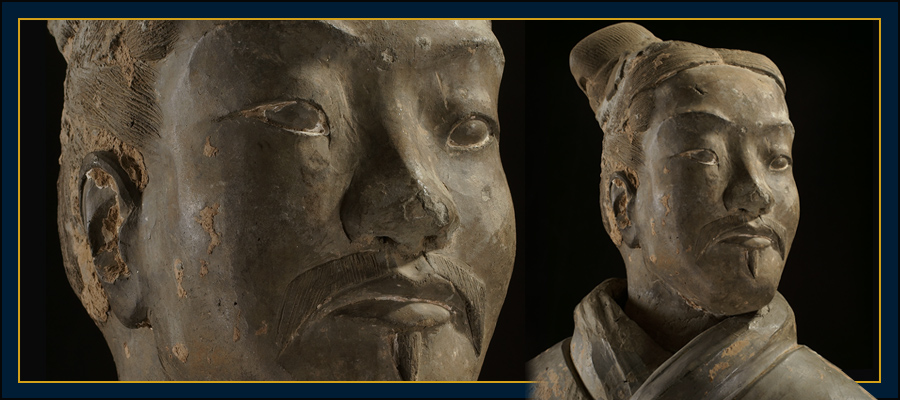
Standing Archer
Qin dynasty (221-206 BC)
Earthenware
H. (71.6 in.) W. (37.8 in.)
Excavated from Pit 2, Qin Shihuang’s Mausoleum, 1997
Emperor Qin Shihuang’s Mausoleum Site Museum, 002818
This figure is one of about 300 archers that were part of The First Emperor’s army.
How do we know he is an archer? Think about how you would stand if you were holding a bow and arrow. Take a look at the position of his hands, arms and feet. With one foot turned outward, he aims down as if drawing back a bow with his right hand. Like the other archers discovered, his eyes are alert and seem focused on the weapon he once held.
You can learn more about the crossbow and see the mechanism that made it work in a display nearby.
Dressed in a padded field robe with a braided topknot, he originally stood in a formation around a group of kneeling archers who were protected by armor. One of the kneeling archers is on display in this room.
Close
Tour Stop:216
Crossbow Trigger Mechanism
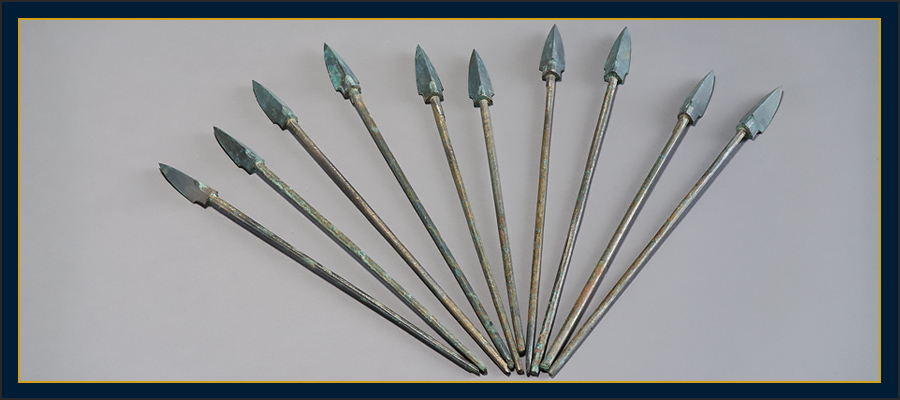
Crossbow Trigger Mechanism
Qin dynasty (221-206 BC)
Bronze
L. (6.4 in.) H. (7.1 in.)
Excavated from Pit 1, Qin Shihuang’s Mausoleum, 1984
Ten Arrowheads
Qin dynasty (221-206 BC)
Bronze
L. (4.4 – 6.4 in.)
Excavated from Pit 1, Qin Shihuang’s Mausoleum, 1974
The crossbow was used in battle hundreds of years before the First Emperor ordered an extra supply made for his tomb burial —but was still a very popular weapon in the Qin dynasty.
An invention of the ancient Chinese, the crossbow was easier to use than a traditional bow, delivering arrows with greater force and at a further distance. In fact, a crossbow could shoot an arrow almost half a mile!
This is the most important part of the weapon: the trigger mechanism. Most of the crossbow was originally made of wood, a material that decays over time. Since this mechanism is made of bronze, archeologists have been able to figure out how the original weapon would have worked, and looked.
Also on display are ten bronze arrowheads and stems that once belonged the First Emperor’s terracotta army.
Close
Tour Stop:217
Armor and Helmet
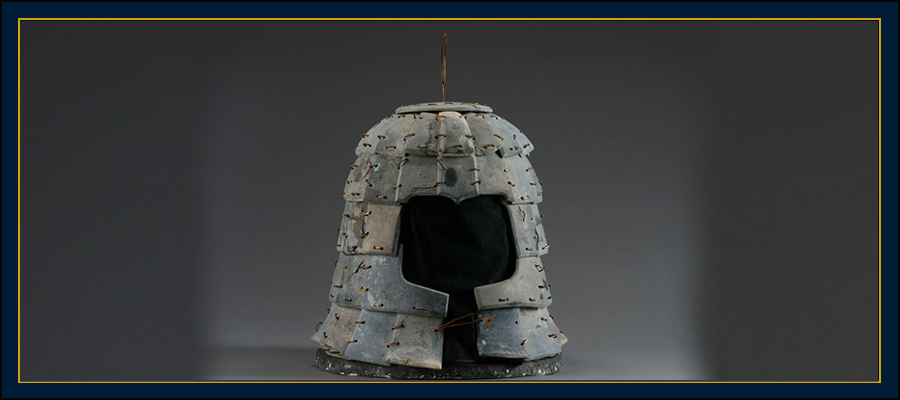
Armor
Qin dynasty (221-206 BC)
Limestone
H. (30.3 in.) W. (19.7 in.)
Excavated from Pit K9801, Qin Shihuang’s Mausoleum, 1999
Shaanxi Provincial Institute of Archaeology, 007094
Helmet
Qin dynasty (221-206 BC)
Limestone, copper wire
Excavated from Pit K9801, Qin Shihuang’s Mausoleum, 1999
Weighing nearly forty pounds with about 700 individual pieces, this armor was designed to cover the shoulders, torso, and abdomen of a soldier. The helmet, made of about seventy-five limestone plates, covered the entire head, leaving openings for only the eyes, nose, and mouth.
Imagine wearing this and trying to walk around. Luckily, Qin soldiers would not have worn this in life- combat armor was actually made of leather or metal, which was much lighter in weight.
Who did wear it? No one! These pieces imitate real armor in shape and design, but they were probably made for the First Emperor’s armory– a place where weapons would have been stored for the afterlife.
Making the armor and helmet would have taken a very long time and required a lot of skill. They are made from limestone and copper. Hundreds of limestone plates had to be cut to precise measurements and then drilled with eight to twelve small holes each before being sewn together with copper wire.
It is estimated that it took between 150 to 350 hours to complete each of the 130 stone garments excavated from this pit. If you worked eight hours a day, it would have taken between 19 and 45 days to complete each one!
Close
Tour Stop:218
Goose
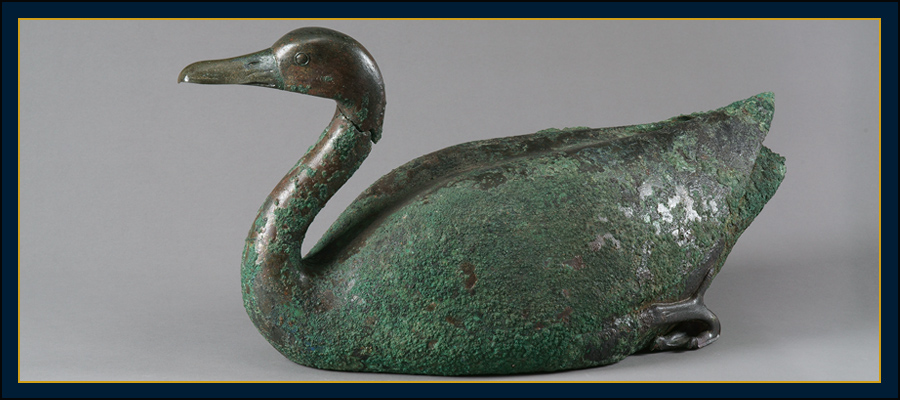
Goose
Qin dynasty (221-206 BC)
Bronze
H. (6.7 in.) L. (20.9 in.) W. (9.4 in.)
Excavated from Pit K0007, Qin Shihuang’s Mausoleum, 2000
Suppose you are an archaeologist excavating armor, household items, warriors and then— a flock of birds?
This goose is one of twenty found in the First Emperor’s afterlife garden along with six cranes and 20 swans –all arranged as if on a riverbank, just as they could be found in nature.
Each bird was cast in bronze and covered in painted clay. They are considered masterpieces of ancient Chinese animal sculpture.
These vivid sculptures capture the moments when the birds are resting, swimming and eating
in the imperial Qin garden. What could this goose be doing?
Close
Tour Stop:219
Cavalryman / Cavalry Horse
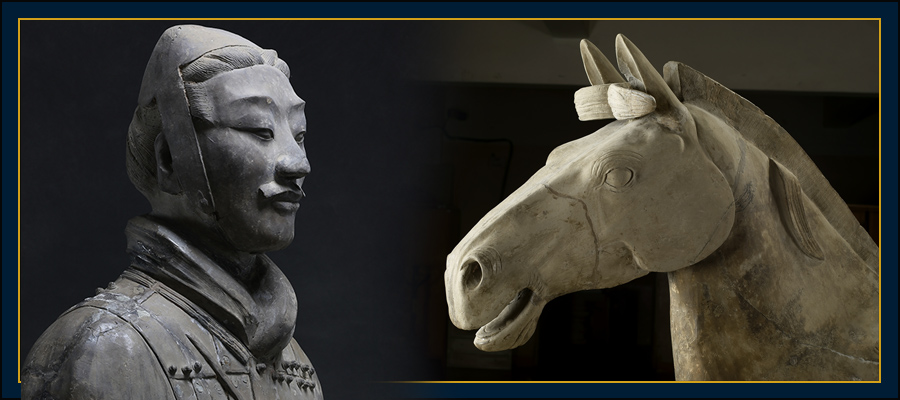
Cavalryman
Qin dynasty (221-206 BC)
Earthenware
H. (72.4 in.)
Excavated from Pit 2, Qin Shihuang’s Mausoleum, 1977
Cavalry Horse
Qin dynasty (221-206 BC)
Earthenware
H. (67.7 in.) L (82.7 in.)
Excavated from Pit 2, Qin Shihuang’s Mausoleum, 1977